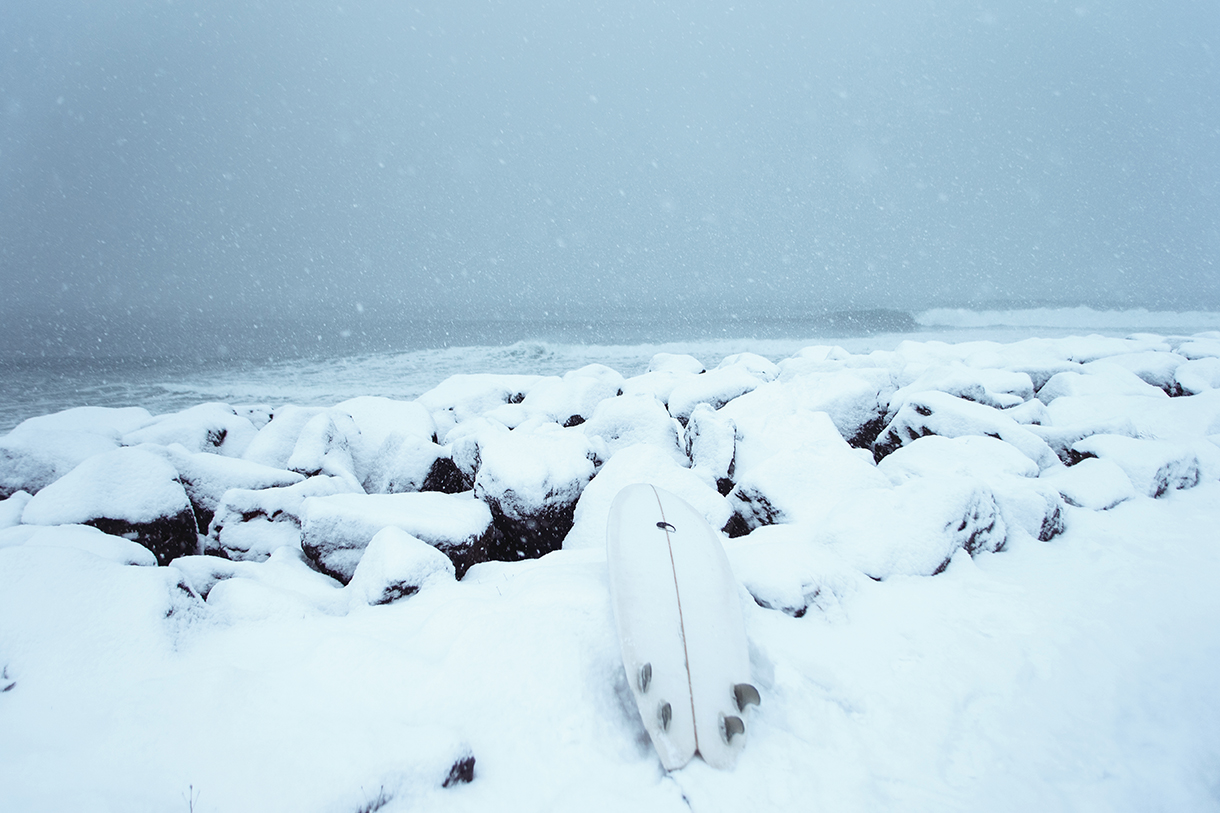
The Call of the North
Wave hunters brave frigid conditions to surf the sea snow.

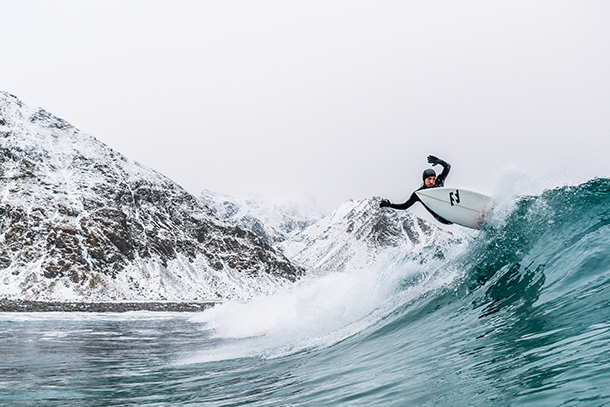
NORWAY: LOFOTEN, NORDLAND
Arctic roadways throughout this 500-square-mile archipelago twist and turn with the rising and falling of the fjords. The sooner visitors accept what Norwegians have long embraced—Mother Nature is undoubtedly the boss—the easier the transition from loathing to enjoying the weather.
LOGISTICS
Fly 2.5 hours from Oslo to Leknes Airport, at the center of Lofoten. Hotel helicopter transfers are possible, but most visitors opt to rent a car, as everything is quite remote. Drive the half hour to Nusfjord Arctic Resort (nusfjordarcticresort.com) to stay in one of 21 crimson overwater cabins otherwise known as rorbu (tip: request cabin 39). Mindfully preserved with shiplap and salty, timber-aged walls, these 120-year-old former fishermen’s quarters were modernized in 2019 with Bluetooth speakers and rainfall showers. These boast uninterrupted views of Vestfjorden’s sheer cliffs as well as the historic harbor. A traditional Scandinavian spread is served for breakfast, including freshly smoked salmon and homemade, harbor-dried stockfish.
THE PAYOFF
Secluded and protected, Norwegian swells are highly seasonal, with everything from knee-high crumblers perfect for longboarding to pumping overhead barrels arriving from September to February. If possible, aim for a session after the sun sets and the Northern Lights fill the sky. Find Unstad Arctic Surf (unstadarcticsurf.com) an hour’s drive from Nusfjord alongside the Norwegian Sea in a tiny town of the same name. Here, the population varies from 12 to 20 residents, depending on the season and the swells. The robust rental program includes a 6/5/4 mm wet suit, booties, gloves, a hood, a board, and access to storage and shower facilities.
From January to April, it’s possible to shred both sea and land. Unstad offers a split board (snow and surf) package, complete with skis or snowboards and avalanche equipment. When the surf isn’t pumping and the elements aren’t cooperating, consider arctic yoga with a post-class ice plunge, a RIB boat tour, or underwater adventures through Lofoten Diving (lofoten-diving.com). Owner and divemaster Pascal Tuchschmid operates the only PADI-certified center in the archipelago. Prepare to pull on 9 mm worth of neoprene and dump hot water into the suit before strapping on the gloves and hood, effectively creating a warm sealant. Hire local sport photographer Hallvard Kolltveit (hallvardkolltveit.com) to capture you doing it all.
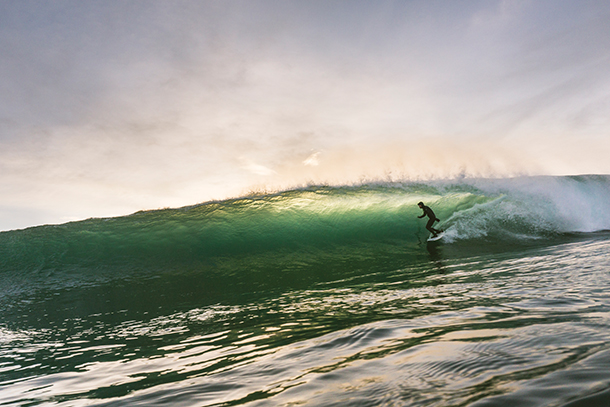
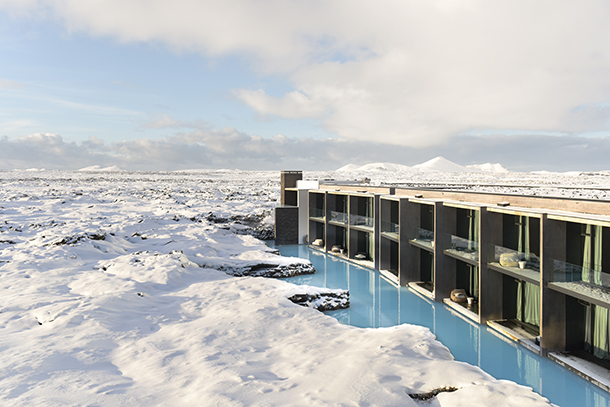
ICELAND: REYKJANES PENINSULA
Imagine the familiar line when sky and horizon meet and mingle in a perfect shade of blue. Throughout the Icelandic winter months, a soft, grayish white—not blue—merges sky, water, and earth under a thick coverlet of fog and snow.
LOGISTICS
It’s surprisingly uncomplicated to navigate among Iceland’s Keflavik International Airport, its premier hotel, and several consistent surf spots. Drive 20 minutes south from the airport to the recently opened Retreat Hotel at Blue Lagoon Iceland (bluelagoon.com) to find some solitude soaking in the private pond outside your Lagoon Suite (be sure to take a midnight float and book a water massage). Come morning, heed the call of much, much cooler waters in the North Atlantic on Iceland’s westernmost coastline. Slide into 5–7 mm booties, 2–5 mm gloves, and a 6/5/4 mm wet suit before ducking into a hood and strapping on your leash. Remember, that attention to detail via gear preparation and execution is essential. When weather and water temperatures trifle at the point of or below freezing, upon exiting the water it’s highly plausible that some extremities will be numb regardless of the thickness of neoprene worn.
THE PAYOFF
The Reykjanes Peninsula (where the airport is) alone proffers nine surf spots. Formed from ancient lava flows, a black sand beach denotes the Sandvik break and the sharp volcanic reef below known as Ollie’s Shipwreck. There’s also Rolling Stones and Grindavik, a trio of breaks that trace the peninsula’s undulating southern headlands. Although some locals surf all year, winter carries larger, more consistent, and powerful swells.
Circumnavigating Iceland, it’s possible to find everything from sandy beach breaks to mellow points, throwing tubes to heavy slabs. Frosty landscapes abound, as do the Northern Lights, if there isn’t a storm. It’s not uncommon for Ingó Olsen, founder of Arctic Surfers (arcticsurfers.com), to spend the better part of a day swell hunting with private-tour and group-lesson customers. The notion of arriving, watching, driving away, returning, checking the tides, double checking the swells, contemplating paddling out, opting out, and then repeating it all again the following day is a very real possibility. Icelandic surfing is as much about the journey and adventure as it is the session. Local photographer Elli Thor Magnusson (ellithor.com) will skillfully capture the best rides and what it takes to find them.
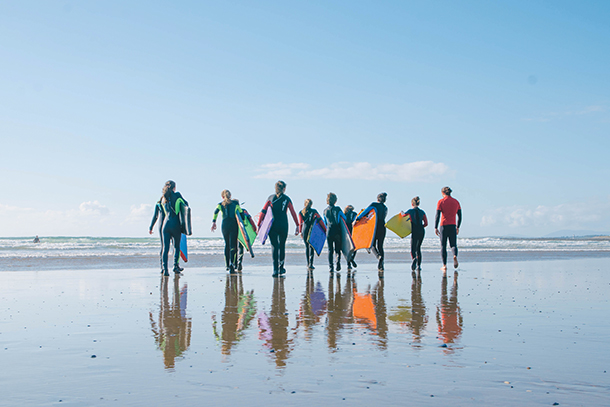
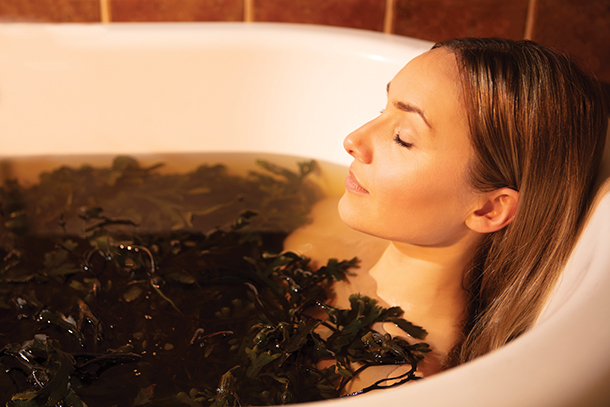
IRELAND: COUNTY SLIGO, CONNACHT
Ireland’s northwest coast bears roughly 100 miles of craggy cliffs and coastline dotted with more than a dozen surf spots ranging from ankle-slapping beach breaks to river mouth sandbars and tow-in surf-worthy mountains of water.
LOGISTICS
A three-hour drive or train ride from Dublin, County Sligo is best navigated by car. While residents claim waves can be found year-round, September through November and April through May produce the best conditions. The frequency of Atlantic swells peaks during those months, although the juggle between tidal ranges and weather conditions will inevitably result in a voluminous amount of offshore, gray days. Unlike some more remote northern destinations, County Sligo counts approximately 70,000 people as inhabitants, which means restaurants and B&Bs aplenty. Both err on the side of quaint. Should greater luxury or privacy be paramount, Temple House (templehouse.ie), a Georgian manor set on 1,000 acres that’s 20 minutes inland, is the best option.
It’s worth noting that due to county regulations, it’s not possible (or easy) to find surfboard rentals. Those traveling without equipment must enroll in lessons or purchase packages with a surf academy. Visit local shaper Conor Canavan’s WaxOn Surfboards (waxonsurfboards.ie) to purchase a locally made sled.
THE PAYOFF
This area is like the cold-water cousin of Australian surfing mecca the Gold Coast, but with three times the area and half the number of surfers. (That’s thanks to cold water, a rainy climate, and perpetually windy conditions.) Local surfers abide by a singular quotation, “There are no strangers here; only friends you haven’t yet met.” Perhaps that’s thanks to the saying’s original author, celebrated Irish poet William Butler Yeats, who called Sligo home. Local legend Seamus McGoldrick runs Sligo Surf Experience (sligosurfexperience .com) from Strandhill Beach, one of the more protected stretches of coastline with a beginner-friendly beach break.
Should Strandhill’s wave prove truculent, head farther west to Easkey’s, a consistent limestone reef break that delivers more powerful peaks. Up north, Mullaghmore, like any big-wave break, lies mostly dormant until just the right northwest swell creates 20-foot waves that slab on a shallow reef. For up-to-date info on the lay of the land, stop into Shells Café (shellscafe.com), a seaside bakery and eatery run by the surfing wife-and-husband duo Jane and Myles Lamberth. Warm up après surf at Voya Seaweed Baths (voyaseaweedbaths.com), a traditional bathhouse. Immerse into a hand-harvested seaweed steam-and-soak ritual or book an organic seaweed oil bathhouse massage.

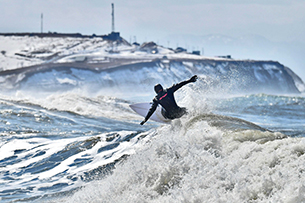
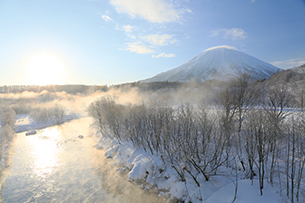

JAPAN: HOKKAIDO
The winds could be strong, the conditions impossible. Or there could be hours of perfect, uninterrupted shoulder-high to overhead waves reeling off a harbor or into a river mouth with no surfer in sight.
LOGISTICS
Navigating a region sparsely populated with hundreds of miles of rugged forest punctuated by fishing villages, locals will joke that they’re searchers more than surfers. Be warned: As with any remote spot, it’s completely possible to get skunked. The shortest part of the journey will be the 1.5-hour flight from Tokyo to Sapporo, Hokkaido’s largest city. Rent an SUV or van; in case of cold or inclement weather, the vehicle will double as a changing area or wind block. Before heading west to the coast, swing through Real Drive Surf and Outdoor Shop (realdrive.jp), a California-style surf shop that provides rentals and more precise road maps, including surf spots. Gloves, hood, booties, and most likely a 5.5 mm wet suit will be necessary.
THE PAYOFF
A massive collection of cold, dry winter air called the Siberian High develops over Russia. Prevailing northwesterly winds cause the advection of cold air from Siberia to Japan, bringing heavy snowfall and short-range wind swell across the Sea of Japan to Hokkaido, the second-largest and northernmost of the main Japanese islands. That wind swell ignites the beaches, reefs, and river mouths of Hokkaido’s west coast, creating barreling conditions and swell lines to the horizon.
Shioya, a big bay with lefts, rights, and beach breaks depending on the swell, also features views of Mount Yōtei, an active volcano that’s nearly always snow-brushed. According to locals, checking the surf spot allows for an informed decision to either continue along the coast to Kinchanchimae point or Ishikariwan, the sandbar at Furubira river mouth. (Tip: Each locale requires a different set of wind and swell directions; if one spot isn’t working, there’s a good chance another might be.)
Should the conditions prove unwieldy, proceed to Zaborin Ryokan (zaborin.com) at the foot of Mount Niseko-Annupuri. Each of its 15 villas boasts a private indoor and outdoor onsen (natural hot spring) filled with free-flowing volcanic spring waters. Choose between a washitsu (tatami floor with futons) or yoshitsu (Western-style bed). The root of the ryokan’s name hails from an amalgamation of the Zen meditation word meaning “to sit and forget,” along with the Japanese character for “woods.” The 2.5-hour ride to Bishabetsu, a remote river mouth, is marked by a traditional Japanese shrine of the same name. Needless to say, there’s plenty of parking. Still further north is Segoshi, a vast beach with several peaks within the town of Rumoi. After a session, head to Jyanome (rumoi-jyanome.com), the first sushi restaurant to open over 50 years ago in Rumoi. They currently hold seniority over any brokering and trading rights with local fishermen, allowing them first pick of each fresh catch.


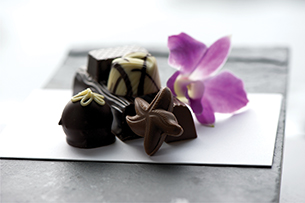
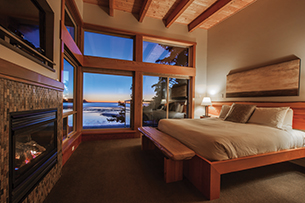
CANADA: TOFINO, BRITISH COLUMBIA
This district on the west coast of Vancouver Island located within the Clayoquot Sound is known as a small surf town that runs along the Esowista Peninsula. Descending by plane through an opaque blanket of cumulonimbus clouds, you can spot a vast number of ultramarine-hued inlets and a million acres of ancient rainforest.
LOGISTICS
Charter a seaplane and prepare for a dramatic, capricious arrival via Atleo River Air Service (atleoair.com). Should the wind or weather prove uncooperative, the more predictable ingress lies with Pacific Coastal Airlines (pacificcoastal .com). Pacific Sands Beach Resort (pacificsands.com), a Tofino mainstay since 1973, rents split-level beach houses fully equipped with dual fireplaces, full kitchens, double-soaking tubs, and tree-lined views of Cox Bay—which is Tofino’s most consistent surf break and home to the Canadian Surf Championships. Suit up indoors (the ultimate cold-weather surfer’s luxury), pulling on a 6/5/4 mm or 5.5 mm wet suit. An on-site outpost of Surf Sister (surfsister.com) exclusively provides rental gear and facilitates group, private, and family lessons.
THE PAYOFF
Northwest winds are the fiercest combatant at Cox Bay, flattening swells and creating howling onshore conditions as strong as tropical trade winds. Dawn patrol is the easiest way to avoid blown-out waves, but heed the tides as they often swing 12 or more feet in half as many hours. Finding the golden ratio of wind to tides to daylight is the eternal Tofino challenge. There are a handful of other surf spots, including Chesterman Beach, Rosie Bay, and Mackenzie Beach, but whether it’s a peeling, mid-bay A-frame or a steep off-the-rocks right hander, Cox Bay remains a more consistent break than its neighbors.
While it may seem counterintuitive here to crave gelato, the locals’ post-surf spot is frequently Chocolate Tofino (chocolatetofino.com). The Lavender Honey gelato routinely sells out, as does the Hammerhead, a secret flavor that’s as gray as its name suggests. Everything sold is crafted on-site, a common theme throughout the coastal town of roughly 2,000 people. Another worthy dryland pursuit: dinner at Wolf in the Fog (wolfinthefog.com), where Chef Nick Nutting and his team fish and forage for local ingredients like mushrooms and seaweed. Simple dishes like the baked Tofino halibut with radish and pork hock, or the potato-crusted oyster with peas and fennel, achieve bold flavors. Before heading back to the resort, stop into the Roy Henry Vickers Gallery (royhenryvickers.com), built by the Canadian First Nations artist himself in 1986. The shop is modeled after a traditional Northwest Coast longhouse and sells the limited-edition prints, totem poles, and original paintings that line its hand-adzed cedar walls.




